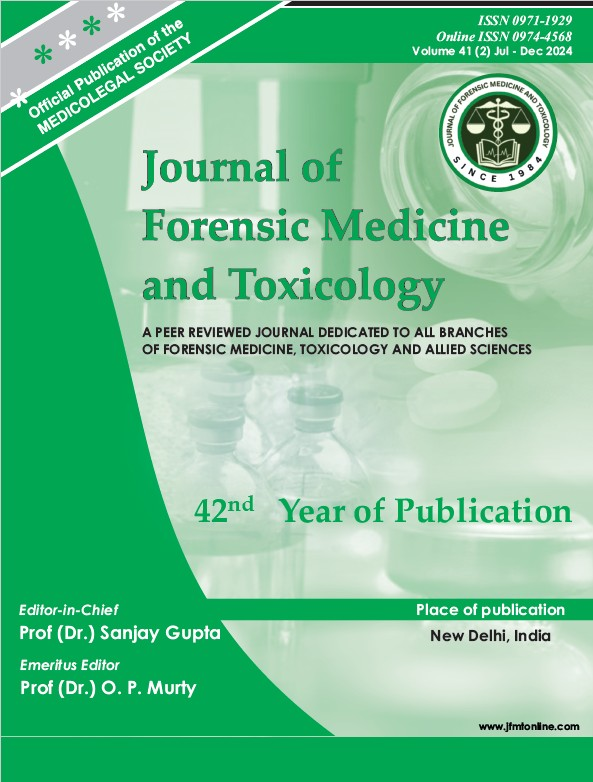COMPARISON OF THE DNA CAPTURE PERFORMANCE OF THE FABRICATED NOVEL MICROCHIP AND FTA® PAPER FOR HUMAN BLOOD SAMPLES
Keywords:
On-chip method, PMMA(Poly methyl methacrylate), Fusion-5- filter paper, Plasma treatment, APTES functionalization, Highest DNA capturing and FTA® paperAbstract
Development of miniaturized devices for analytical processes has been a progressive trend over several decades. The immense potential for implementation of such devices in the form of “Lab-on-a-chip” technology was demonstrated. “Lab-on-a-chip” (LOC) devices in the form of membranes or beads have been fabricated as an advanced technique for DNA extraction, offering fast analysis, minimal sample requirement and no contamination. The present study reports fabrication of a polymer based Microchip offering rapid and low cost extraction of DNA from blood samples in a short time. The Microchip was prepared by introducing a disc of fusion 5-filter paper between two Poly (methyl methacrylate) (PMMA) layers where the activated polymer substrate acted as a solid DNA binding phase. DNA extraction from human blood was carried out on a Microchip using an alkaline extraction method and quantitated using RT-PCR followed by amplification and STR genotyping. The DNA binding capability of the fabricated Microchip was evaluated and compared with the FTA® paper by measuring the concentration of DNA in the final elutes using RT-PCR. On-chip DNA extraction suggests that the DNA holding capacity of the fabricated Microchip was better than the FTA® paper. The efficiency of the fabricated microchip for DNA isolation from blood, refractory to DNA concentrations in the elute is significant as compared to FTA® paper. The device is cost effective and efficient; therefore, it is expected to succeed in cases where DNA quantity is low.
Downloads
References
Horsman KM, Bienvenue JM, Blasier KR, Landers JP. Forensic DNA analysis on microfluidic devices: A review. J Forensic Sci. 2007;52(4):784–99.
Christel LA, Petersen K, McMillan W, Northrup MA. Rapid, automated nucleic acid probe assays using silicon microstructures for nucleic acid concentration. J Biomech Eng .1999;121(1):22–7.
Duarte GRM, Price CW, Littlewood JL, Haverstick DM, Ferrance JP, Carrilho E, et al. Characterization of dynamic solid phase DNA extraction from blood with magnetically controlled silica beads. Analyst. 2010;135(3):531–7.
Azimi SM, Nixon G, Ahern J, Balachandran W. A magnetic bead-based DNA extraction and purification microfluidic device. Microfluid Nanofluidics. 2011;11(2):157–65.
Wang Y, Qi W, Wang L, Lin J, Liu Y. Magnetic bead chain based continuous flow dna extraction for microfluidic pcr detection of salmonella. Micromachines. 2021;12(4).
Berensmeier S. Magnetic particles for the separation and purification of nucleic acids. Appl Microbiol Biotechnol. 2006;73(3):495–504.
Hassanpour-Tamrin S, Sanati-Nezhad A, Sen A. A simple and low-cost approach for irreversible bonding of polymethylmethacrylate and polydimethylsiloxane at room temperature for high-pressure hybrid microfluidics.. 2021;11(1):1–12.
Reedy CR, Price CW, Sniegowski J, Ferrance JP, Begley M, Landers JP. Solid phase extraction of DNA from biological samples in a post-based, high surface area poly(methyl methacrylate) (PMMA) microdevice. Lab Chip. 2011;11(9):1603–11.
Chan CH, Chen JK, Chang FC. Specific DNA extraction through fluid channels with immobilization of layered double hydroxides on polycarbonate surface. Sensors Actuators, B Chem. 2008;133(1):327– 32.
Witek MA, Llopis SD, Wheatley A, McCarley RL, Soper SA. Purification and preconcentration of genomic DNA from whole cell lysates using photoactivated polycarbonate (PPC) microfluidic chips. Nucleic Acids Res. 2006;34(10):1–9.
Sypabekova M, Hagemann A, Rho D, Kim S. Review: 3-Aminopropyltriethoxysilane (APTES) Deposition Methods on Oxide Surfaces in Solution and Vapor Phases for Biosensing Applications. Biosensors. 2023;13(1).
Wong I, Ho CM. Surface molecular property modifications for poly(dimethylsiloxane) (PDMS) based microfluidic devices. Microfluid Nanofluidics. 2009;7(3):291–306.
Wieland F, Bruch R, Bergmann M, Partel S, Urban GA, Dincer C. Enhanced protein immobilization on polymers-A plasma surface activation study. Polymers (Basel). 2020;12(1):1–12.
Wimbles R, Melling LM, Shaw KJ. Combining electro osmotic flow and FTA® paper for DNA analysis on microfluidic devices. Micromachines. 2016;7(7).
Guillen GR, Pan Y, Li M, Hoek EM V. Preparation and Characterization of Membranes Formed by Nonsolvent Induced Phase Separation/ : A Review. 2011;3798–817.
Abdel-Fattah E. Surface Activation of Poly(Methyl Methacrylate) with Atmospheric Pressure Ar + H2O Plasma. Coatings. 2019 ;9:228.




